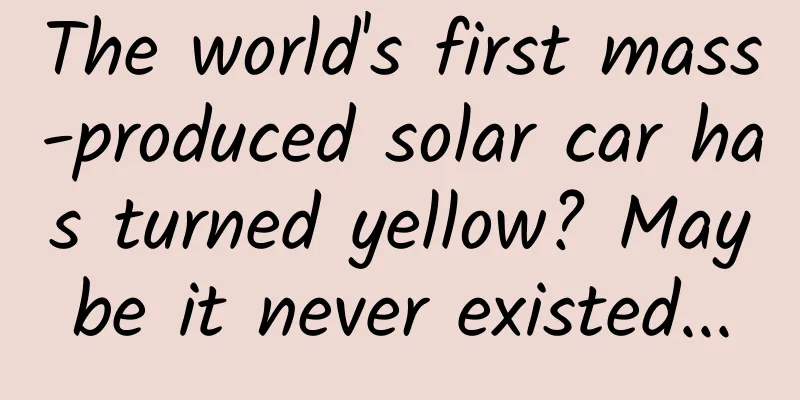The world's first mass-produced solar car has turned yellow? Maybe it never existed...

|
The world's first solar car went bankrupt just two months after mass production. Is the solar car the inevitable outcome of the capital game, or a brief twist in the road of exploring new technologies? Written by reporter Zhao Tianyu, Photo and text editor Chen Yongjie Interview experts Yu Zhenhua (Executive Vice Chairman of Zhongguancun Energy Storage Industry Technology Alliance) Liu Weiguo (Assistant Director of the National Intelligent Connected Vehicle Innovation Center) In recent years, electric vehicles have become a popular option in the current automotive field, but battery life is still a problem that needs to be solved. Previously, a Dutch manufacturer called Lightyear brought a new idea - solar electric vehicles, which use solar energy to recharge vehicles to improve their battery life. However, according to foreign media reports recently, Atlas Technologies BV, the parent company of Lightyear and the company responsible for the production and operation of Lightyear 0, filed for bankruptcy, and the world's first mass-produced solar car "failed". ▲In January 2023, Atlas Technologies BV, the parent company of Lightyear and the company responsible for the production and operation of Lightyear 0, filed for bankruptcy (Photo source: Lightyear official website) As a new energy source, the photovoltaic technology that uses solar energy to replace charging is not amazing, but its application in the automotive field still provides a new way to solve the endurance problem of new energy vehicles, and has therefore attracted worldwide attention. The unfinished project of Lightyear Motors is thought-provoking. Is this the inevitable outcome of the capital game, or a short setback in the exploration of new technologies? Is there still a future for solar cars? Can you drive in the sun? Most of them are hybrid products Lightyear actually originated from the entrepreneurial team of the University of Eindhoven in the Netherlands. The team won the Bridgestone World Solar Challenge in 2013, 2015 and 2017, and Lightyear Automobile is the product of their "technological achievement transformation". In September 2016, Lightyear was officially established in the Netherlands, dedicated to building long-range electric vehicles that are independent of the power grid. In chronological order, Lightyear has launched a total of three models, namely Lightyear 1, Lightyear 0 and Lightyear 2. Lightyear 1 is a prototype, Lightyear 0 is the mass-produced version of Lightyear 1, and Lightyear 2 is a concept product that has not been mass-produced. ▲Lightyear Car No. 0 (Photo source: Lightyear official website) In December 2022, Lightyear began mass production of Lightyear 0. Although the price is as high as US$250,000 (approximately RMB 1.7 million), it is still the world's first mass-produced electric car that directly uses sunlight to generate electricity. How does the Lightyear 0 "move"? According to official information, the roof and front hood of the Lightyear 0 have nearly 5 square meters of solar panels, which are devices that directly convert light energy into electrical energy through the photovoltaic effect. However, a single photovoltaic cell cannot generate enough electricity. Silicon crystals are laminated into p-type and n-type layers, stacked on top of each other. Light shining on the crystals triggers the "photovoltaic effect" and generates electricity. Specifically, the principle of this "photovoltaic effect" is that when sunlight shines on a solar panel, light particles bombard the surface. The photons transfer their energy downward through the silicon crystal, and then release the energy to the electrons in the p-type layer. The electrons use this energy to jump over the potential barrier into the upper n-type layer and escape into the circuit. The electrons flow around the circuit, thereby generating electricity. If there is enough sunlight, the charging power of the solar panel is 1.05 kilowatts. It can travel 10 kilometers after charging for one hour, and 60-70 kilometers after being left for half a day, which can meet daily commuting needs in the city. However, strictly speaking, Lightyear 0 cannot be considered a pure solar car. At most, it can be considered a hybrid product , because its main power source still relies on a 60-kilowatt battery pack. Its range under WLTP conditions is 625 kilometers. The power provided by the solar panels is only supplementary, and lithium batteries are its main driving force. Chinese companies have also participated But commercialization is not going well In fact, at the beginning of 2023, Lightyear also participated in the 2023 CES Consumer Electronics Show and brought its second prototype, Lightyear 2. Who would have thought that a month later, the manufacturer declared bankruptcy, and the speed of its death was astonishing. ▲The second prototype car Lightyear 2 participating in the 2023 CES Consumer Electronics Show (Photo source: Lightyear official website) Although Lightyear Auto did not disclose the reason for its bankruptcy, analysts generally believe that it is related to the broken capital chain: after all, the price of Lightyear 0 is as high as 1.7 million RMB, which is much more expensive than many luxury cars. After the launch, Lightyear 0 only received 150 pre-orders, which seems to be insufficient to cover the production costs. The demise of Lightyear Auto reflects the plight of the industry. Solar car companies at home and abroad are also facing similar problems such as lack of funds and low product recognition. ▲Lightyear car production line (Photo source: Lightyear official website) For example, the Munich-based startup Sono has raised a total of $126.6 million (about 872 million yuan) in five years, which is less than a fraction of Weili, Xiaoli and Li Auto. In December last year, Sono launched a fundraising campaign, but the funds raised in the end still could not meet the needs of mass production. Aptera, a California-based company, is also a participant in the solar car race. However, Aptera's co-founder publicly stated at the beginning of this year that on top of the $85 million in financing, Aptera will need an additional $50 million in capital this year to reach the first hurdle of mass production of solar electric vehicles. ▲Aptera, a California-based company, is also a participant in the solar car race (Image source: www.inc.com) As for big-name car companies, Toyota equipped its hybrid Prius with optional solar panels as early as 2010, but the technology did not take shape, and Toyota also turned to research on hydrogen energy. In 2016, while Tesla was researching pure electric vehicles, it also asked company engineers to study the feasibility of solar roofs, but the project was later proven to be "unworkable." In China, photovoltaic giant Hanergy Group proposed to make solar cars as early as 2016, and released four fully solar-powered cars with different positioning - Solar O, Solar A, Solar R and Solar L. It claimed to have "unlimited driving without plugging in" and even reached a technical cooperation with Audi, but there has been no news since then. It was not until June 2022 that the Tianjin, China's first intelligent connected car that is completely powered by pure solar energy and does not use any fossil fuels or external power sources, was officially launched. However, its range is only 74.8 km, and the cost of a single unit is as high as 10 million. ▲In June 2022, China's first "Tianjin" powered entirely by pure solar energy was officially launched (Photo source: The Paper) ALL in the Electric Vehicle Era Is there still hope for solar cars? In the current era when global automakers are all in on electric vehicles, are solar-powered cars reliable? At least at this stage, they still face many challenges in terms of technological maturity, practical value and production costs, and the road to commercialization is full of difficulties. Yu Zhenhua, executive vice president of the Zhongguancun Energy Storage Industry Technology Alliance, pointed out in an interview with reporters that the biggest technical bottleneck of solar energy is its low energy conversion rate, which is only 20%-25% at most. In addition, its stability is relatively poor and fluctuates, which cannot meet travel needs and is difficult to use directly as vehicle power. Therefore, most existing solar cars are a combination of "solar panels + batteries". Calculated based on the 5 square meters of solar panel coverage per car, the average daily power generation of a solar car is only about 6 degrees, which is basically consistent with the Lightyear 0 mass-produced car. At present, the power consumption of electric cars is generally 15 degrees per 100 kilometers, so the ideal range of solar cars is only 70-80 kilometers, and it is difficult to reach 100 kilometers. Weather factors are also the nemesis of solar cars. In the case of insufficient light, the conversion rate of solar panels will further decrease, and the range will be more seriously reduced. In addition, particulate matter in the air (such as dust) settles on the surface of solar cell modules, blocking part of the light, which will also reduce the conversion efficiency of the battery modules, resulting in reduced power generation and even damage to the panels. The technical drawbacks have raised the production cost of solar cars, and consumers have to face the reality of paying tens of thousands or even hundreds of thousands of yuan to add an inefficient power generation module. Therefore, it is difficult for this niche technology route with advanced concepts and unclear prospects to find a sustainable source of funds. This may be the important reason why many companies are facing financial difficulties or simply give up halfway. Liu Weiguo, assistant director of the National Intelligent Connected Vehicle Innovation Center, said that photovoltaic technology has been developed for many years, but practice has proved that it is not suitable for use in automobiles, especially after the rapid development of lithium batteries, the application scenarios (in automobiles) are even fewer. He believes that unless there is a breakthrough innovation in photovoltaic materials in the future, the prospects for solar cars are not optimistic. ▲A panoramic view of the Tongliang Yuquan “solar energy storage charging inspection and replacement” integrated station of State Grid Chongqing Electric Power. (Photo source: State Grid Chongqing Electric Power Company) But solar cars are not completely useless. Currently, due to factors such as high oil prices, insufficient supply of parts, and soaring raw material prices, traditional fuel vehicles are facing considerable cost pressure, and the electric vehicle industry is also facing fierce competition and serious internal competition. Solar energy can be used as an auxiliary charging device or power device for vehicles. If the cost is properly controlled, solar cars can also meet the needs of short-distance commuting, which is still of great significance for green travel. From the perspective of energy storage, Yu Zhenhua believes that an integrated solution similar to "solar energy storage and charging" is also a path. Make good use of photovoltaic power generation systems, energy storage systems and charging piles, build new photovoltaic charging stations that use solar energy to charge, and optimize energy storage and configuration. However, due to factors such as electricity prices, relevant policies need to be strengthened to support and enhance the enthusiasm of enterprises to participate. Produced by: Science Central Kitchen Produced by: Beijing Science and Technology News | Beijing Science and Technology Media Welcome to share to your circle of friends Reprinted by public accounts, newspapers, etc. |
<<: The Hengduan Mountains glaciers are precious because they are rare.
>>: Can plants catch a cold or have a fever? - Plant Attack and Defense
Recommend
Zhaoqing Mini Program Development Company, how much does an electrical mini program cost?
How much does it cost to attract investment throu...
Yuan Zhenren's "Movie Commentary Copywriting System" uses director's thinking to make in-depth copywriting courses for movie commentary
Course Contents: 1. Things to note when learning ...
Windows Phone's itch for domestic market share
Windows Phone (abbreviated as WP) is a mobile pho...
6 techniques to help you promote your products step by step
If any product wants to develop sustainably, it m...
In the mini-app war between BAT and others, who is more likely to be the winner?
[[246273]] summary: Why do BAT attach so much imp...
How did Honor of Kings, which has over 50 million daily active users, become so popular?
On the bus, on the subway, after company dinner, ...
What are numbers? How do our brains perceive numbers?
A philosophical question has gradually evolved in...
The gradually disappearing Northeast Internet: Hometown is the way out of the cage
Legend has it that there is a unique genre of wri...
How to make a good online event promotion plan?
In marketing psychology, herd mentality, greed fo...
What happened to the "spy whale" that can help people pick up mobile phones?
In 2019, a beluga whale suspected to be a Russian...
Is your product suitable for WeChat mini program? You need this product logic analysis!
On the evening of September 21, WeChat announced ...
The underlying logic of fission, how to make your fission lasting and effective?
The reason I wrote this article is that I was rec...
Huawei's Last Mile
[[132497]] In 2014, Huawei won the crown with glo...
Not only to the sky, but also to the earth! How much do you know about the expectations from deep inside the earth?
Going up to the sky, going down to the sea, and g...
Today, to all the parents at home! Please share "A loving family"
Expert in this article: Yang Jing, PhD in Immunol...









